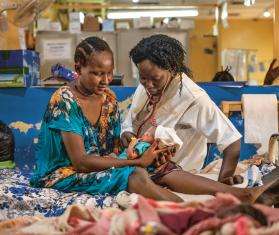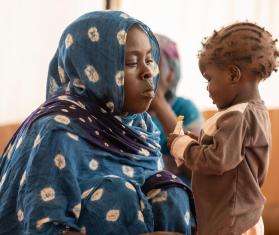Unsafe abortions, those performed without any medical supervision and often undertaken in poor sanitary conditions, can lead to fatal complications for women and girls. Abortion-related complications, which Doctors Without Borders/Médecins Sans Frontières (MSF) staff in the field see frequently, are among the leading causes of maternal mortality worldwide, but especially in developing countries.
In response to the overwhelming need for access to safe abortion care in many of the places where MSF works, the organization began offering these services in a limited capacity in 2004. Catrin Schulte-Hillen, MSF’s advisor on reproductive health, talks here about the challenges MSF faces in implementing safe abortion care on a larger scale.
Why has MSF committed specifically to safe abortion on request in the field?
The complications associated with unsafe abortions (those not carried out under medical supervision) are among the most common causes of maternal mortality.
Yet at the same time, these are the only cases (of maternal mortality) that can actually be entirely anticipated and prevented.
In 2014 and 2015, MSF teams treated more than 20,000 women with abortion complications including severe hemorrhaging, infections, and peritonitis. These can cause injury, sterility, and even death.
We estimate that between 50 and 80 percent of the complications were due to abortions carried out in poor conditions and/or by unqualified personnel.
In developed countries the percentage of unsafe abortions is around six percent, while in Africa and Latin America, it’s 97 percent and 95 percent respectively.
Since 2004, access to safe abortions, those under medical supervision, has been an official part of healthcare services provided by MSF teams in the field.
Our teams have three key responsibilities: respecting the reason the woman or girl gives for wanting to have an abortion; ensuring she can discuss her desire to have an abortion with medical staff, and make an informed decision; and to provide quality medical care.
However, between 2013 and 2015, only 25 to 35 percent of MSF projects that were supposed to provide abortions were actually doing so.
This is still quite low, given that MSF provides maternal care to around 200,000 women each year.
Still, the figure is on the rise and demonstrates the gradual progress we are making in this area.
What is preventing MSF teams from providing safe abortion?
The main reasons are internal to MSF.
The most common arguments we hear, at various levels within the organization, are: “there isn’t the need;” “it’s too complicated;” or even “it’s not the role of MSF.”
These reasons tend to reveal things about the staff themselves—discomfort with the initiative, lack of knowledge surrounding the issue, or a personal objection. In most societies, there are strong social standards and prejudices linked to abortion, including a certain degree of reticence to practice, or even talk about it.
We need to take these social considerations into account, while creating an environment that enables medical staff to express their professional convictions and concerns about abortion. From this, we can help each individual reach a balance between personal opinion and professional responsibility.
Are the obstacles to abortions also legal issues in some cases?
You have to be wary of legal arguments, especially when they are used to prevent someone from having a medically supervised abortion.
These arguments can conceal a poor understanding of the actual legal framework around abortion. More importantly, they do not give sufficient priority to the medical needs or personal wishes of the women involved.
For context, abortions are completely illegal in only six countries around the world, none of which are in Africa or Asia. In 97 percent of countries, they are allowed only when it’s necessary to save the woman’s life. Sixty percent extend this to when it’s necessary for health reasons (including mental health). Furthermore, over 50 percent of countries allow abortions for pregnancies causes by rape.
However, even where there’s legal flexibility, this doesn’t exclude the possibility of legal action.
These hurdles have to be looked at from a broader perspective, balanced out by focusing on the respect and safety of the women involved.
With each abortion case, you have to evaluate the following: the interpretation of the local laws, the local customs, and the presence of medical facilities able to carry out safe abortions and which we can recommend to women.
Are there risks associated with carrying out abortions for the MSF teams?
Safe abortions are an obvious medical need, yet still very neglected. MSF must not give up on dealing with this problem just because “it’s complicated”.
We have to be ready to accept and deal with conflicts and possible repercussions while striving to reduce the risks for women.
In countries with particularly strict rules on abortion, MSF’s international staff assume the responsibility for carrying out procedures.
Confidentiality is also of utmost importance, to protect women and young girls who have chosen to have an abortion.
It’s vital to communicate clearly about the issue, explaining our medical mission, and our arguments and justifications for providing this type of care, to women who request it.
Our opportunity to change attitudes towards abortion often depends on our ability to create a dialogue on the issues; dialogue both with MSF medical staff and other healthcare professionals in local communities.
Read more about the consequences of unsafe abortion in Because Tomorrow Needs Her
Catrin Schulte-Hillen is the main author of the paper ‘Why Médecins Sans Frontières (MSF) provides safe abortion care and what that involves’ , published on the online medical portal: BioMed Central.




